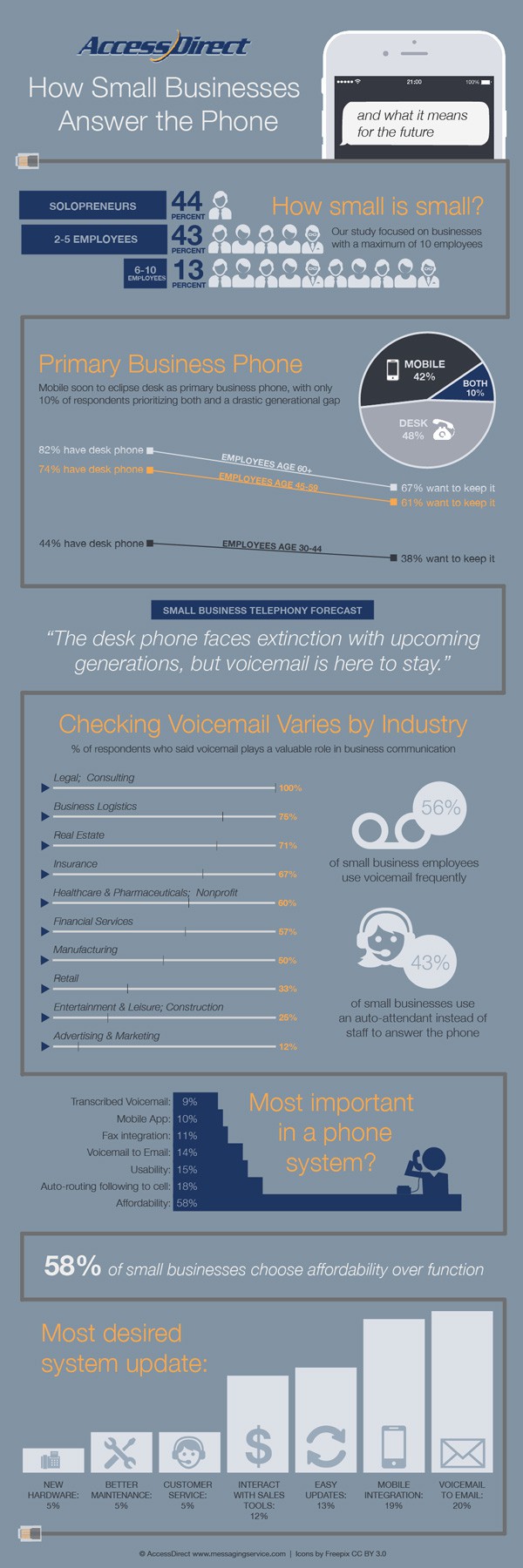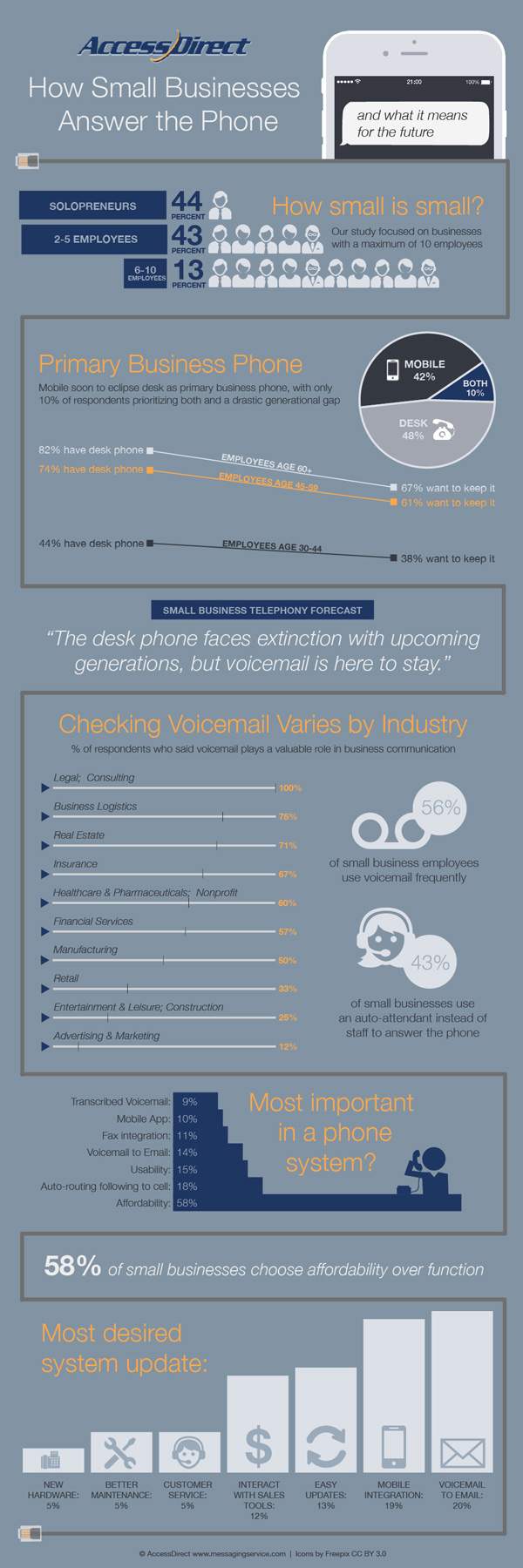I remember installing our first small business phone system here at AccessDirect. Among other headaches, I precisely recall being crouched down under my desk drilling through the wall so I could run a cord to connect my first employee to our phone line.
That was 20 years ago. If someone would have told me I could throw all the cords away and that my phone lines could exist wirelessly through the internet — I would have handed over that whole tangled bundle in a heartbeat.
Fast forward to today: this morning I was dictating an email to a member of my staff using Siri on my iPhone — from my breakfast table — voice to text to computer without the use of hands or any wiring required. The way we communicate looks almost nothing like it did in 1997. Or at least, it doesn’t have to. But when it comes to business phones many small business owners are still stuck with their bundle of cords, dense user manuals, and hefty overhead of a traditional phone system.
Small Business Phone System Survey Results
I was somewhat surprised to learn in our 2014 Small Business Phone System Survey that small businesses valued saving money over functionality. Big corporations might not update because of the sheer size of the task — but I can only imagine that small companies don’t update because they simply don’t have time. The telephone is a utility – as long as it works, it works. Juggling all the moving parts of a small business can force an attitude of “if it’s not broken, don’t fix it”. When it comes to small business operations, that can stick small companies in the past, which doesn’t serve well for productivity or staying ahead of the competition.
It also doesn’t help the budget. Entrepreneurs overwhelmingly choose affordability over functionality when it comes to their small business phone system, yet over half are still paying for antiquated systems. They spend money on traditional landlines, legacy system overhead, hardware, and an additional mobile plan, while missing key features that would save time, cut down cost, create leaner operating systems, increase productivity, and feed the sales funnel.
How Small Businesses Answer the Phone
It might sound like a strange question, but after conducting our survey, we saw that small businesses have very specific ways of answering their phones. To start, we defined “small businesses” as those with 10 or fewer employees. These businesses were further broken down into three distinct groups:
- Solopreneurs: These are single owners/employees, often home-based and typically mobile.
- 2-5 employees: Small companies that are often just starting, or which serve a niche market.
- 6-10 employees: Small businesses that are starting to grow and reach a wider customer base.
The goal of our survey was to understand how these different groups of small businesses used phones for their day-to-day work. This included all types of phones — fixed lines at home or the office, mobile phones, and web-based telephony solutions, such as VoIP and cloud-based phones.
Farewell to the Fixed Phone
While fixed phones still represented the largest percentage of phone usage (relative to mobile), the numbers were close. It’s clear that over the next few years, mobile phones will overtake fixed phones for small businesses. There are several reasons for this, including the following:
- The modern business environment demands it. Customers need to be able to get in touch with you outside of business hours, and a mobile phone makes it possible for you to take calls when away from your office. This is especially true if you have global customers and contacts in different time zones.
- Older employees, the most frequent users of fixed phones, retire to be replaced by younger employees who are much more likely to use a mobile phone for their business phone calls. This natural evolution will see the use of fixed phones decrease dramatically.
- A fixed phone can only be used for one thing: calls. A modern smartphone allows for web consultation and use of an unlimited number of business apps that make doing business more efficient and flexible. The cost of a fixed phone is hard to justify when a mobile phone can be used for calls and so much more.

Click Image Above to Enlarge
Another point our survey revealed was while fixed phones are slowly disappearing, voicemail is definitely here to stay. If your callers aren’t able to get through to their desired contact, it’s critical that they remain able to leave a message. The move to virtual telephony is well underway, and we continue to be a valuable resource for small businesses.
At AccessDirect, we work hard to provide solutions specifically for small businesses, which is why we offer Voicemail to Email systems with storage and easy search and reference. This also happens to be the most desired system update (just ahead of mobile integration), serving as proof that we’re offering the intelligent solutions small businesses are asking for.
Affordability vs. Function
Perhaps one of the most troubling points that came up in our survey of small businesses and how they answer the phone was that 58% choose affordability over functionality. This shows just how competitive and price-sensitive the landscape is for small businesses. The problem is that many small businesses may be losing out on customers and market segments due to outdated or inefficient telephony systems that drive customers elsewhere.
To remedy this problem and provide real value for our customers, our small business telephone systems respond to your need for affordable telephony solutions that adapt with you as your business grows. We want to make it easier for your customers to get through to you and for you to respond to them, because your success is our success.
Choosing a Telephone System for Small Business
It’s time for small companies to go virtual with their phone system. Of course I believe this — I sell virtual phone systems for small businesses — but I declare it because the downward trend in the use and preference for traditional landline and desk phones at work is undeniable. Desk phone usage drops by nearly half for the small business employee under 45. Our survey findings predict that by the time today’s children enter the workforce, the desk phone will be extinct. While 61% of 45-60 year olds want to keep the desk phone around at work, only 38% percent of 30-45 year olds want to keep it.
Walking into an office without any desk phones might sound absurd — but if it does, let me direct you to a video from 1974, where Arthur C. Clarke, prominent science writer and futurist, stands in front of a computer the size of our entire office, and predicts the Internet. He forecasts a day where man will have a small console in his home from which he can communicate, access his travel plans, his bank statement, and work from anywhere.
Of course, that prediction that was sci-fi like in 1974 is our very normal reality today.
So without those gaudy black boxes, dial pads and phone jacks in our offices, what does the future of business telecommunications look like? Our survey allows us to envision that.
The answer is in voice-based communications. Despite buzz generating headlines in 2014, such as the New York Times declaring voicemail dead with Millennials, our survey finds that at least among small businesses, the practice isn’t going anywhere soon. In fact, 56% state that voicemail is valuable and that they use it frequently, with an additional 24% stating that voicemail is still important with their clients.
Sure, 12-17 year olds might prefer hiding behind text messages, but I doubt the future of communication is text based. Looking forward to a world with no voice calls mimics the host’s concern in Clarke’s 1974 video, “but what will life be like in social terms, if our whole life is built around computers?” Just like computers didn’t take the place of socializing, neither will text messaging prevail to create a world that is toneless and alienating — now that voice technology is catching up, we can see a future where voice communications have a stronghold in telephony.
As far as doing business, small companies overwhelmingly find voicemail valuable, and that remains static across all age groups with a sufficient sample size (age 30-70).
As I plan the future of my own small company, it is imperative for my team and I to understand what our small business client will need as communication continues its rapid evolvement. As a small business owner (we are still 5 employees after 17 years strong), I get tired of reading big Fortune 500 funded reports on the future and then trying to apply them to the forecasting of my own business. We serve businesses primarily in the same small size as ours: 2-5 employees, and so we limited our survey to respondents who own or work for a business with ten employees or less.
Voice communications are here to stay
As the internet reshapes our world, including the world of telecommunications, in some ways it is reassuring to find that the inherent principle of telephony, voice communications, is not going anywhere. In fact, I project that it will become more powerful than ever, and someday we won’t need hardware at all. It’s a long way from running cords through drywall, but then again, who could have ever believed that phone cords would be replaced by something invisible called “the cloud.”
In our survey, respondents identified two dozen providers of business telephone systems that they employ for their small businesses. This is also something I couldn’t have imagined in 1997. We are a small business among many here in telecom, and it is encouraging to be part of a diverse and healthy market. We publish our survey results not only to exhibit leadership in virtual telephone systems for small businesses, but to encourage them to purchase a small business virtual phone system with confidence based on what the future of telephony looks like.
If you have any questions, feel free to reach out to our team.








Finding the right telephone system for your business involves considerable research. Everything from separate lines for employees to functionality in general must be taken into account.